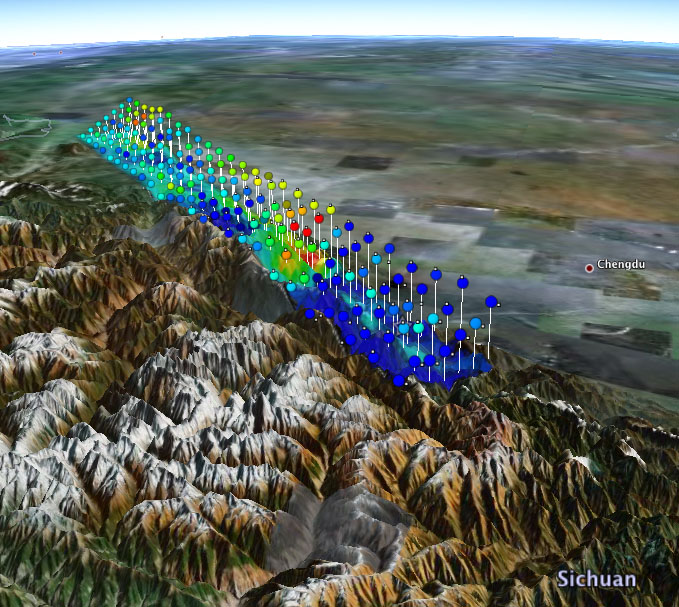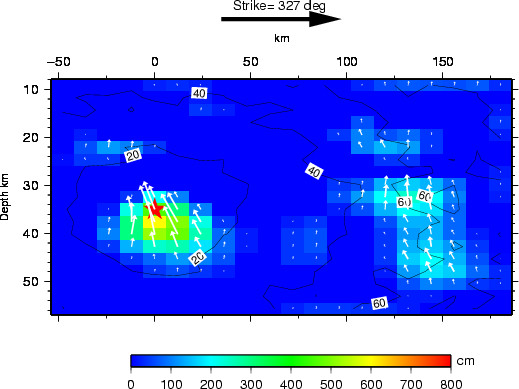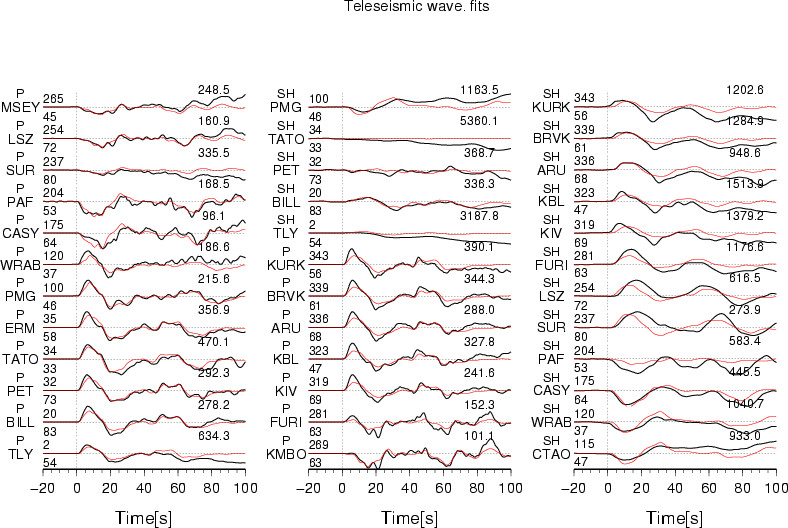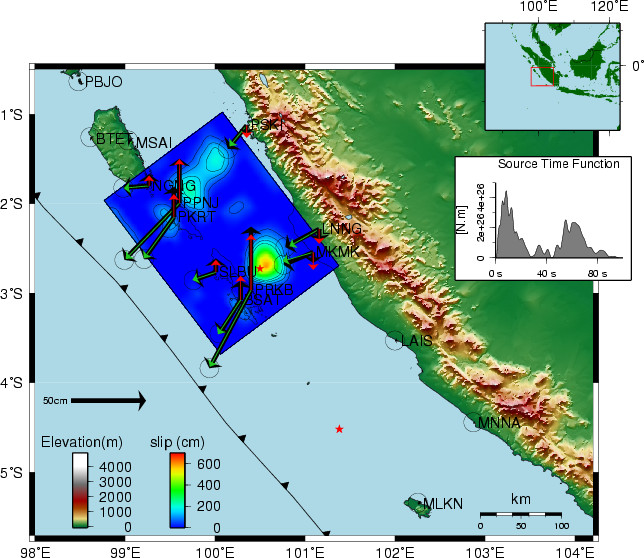Updated Result
09/12/2007 (Mw 7.9) , Central Sumatra Earthquake
A. Ozgun Konca and Anthony Sladen, Caltech
Location of Epicenter |
Amount of Slip on Fault
View in Google Earth (requires Google Earth) Colors show the amount of slip on diferent sections of the fault zone. Two views are shown (either view can be de-selected on the Google Earth sidebar):
|
DATA Process and Inversion
This is an update of our preliminary analysis based on the results published in Konca et al. (2008). The source model is obtained by joint inversion of 27 GPS measurements at stations of the SUGAR network, and 36 teleseismic body waveforms (19 P and 17 SH). The location of the epicenter (Lon.=100.5° Lat.=-2.75°) was moved from the original USGS position to be compatible with the geodetic data. This event follows a Mw=8.4 earthquake which occurred 12 hours before.Result
.Cross-section of slip distribution

Figure: The big black arrow shows the fault's strike. The colors show the slip amplitude and white arrows indicate the direction of motion of the hanging wall relative to the footwall. Contours show the rupture initiation time and the red star indicates the hypocenter location.
Comparison of data and synthetic seismograms

Figure: The Data are shown in black and the synthetic seismograms are plotted in red. Both data and synthetic seismograms are aligned on the P arrivals. The number at the end of each trace is the peak amplitude of the observation in micro-meter. The number above the beginning of each trace is the source azimuth and below it is the epicentral distance.
Map view of the slip distribution

Figure: Surface projection of the slip distribution and fit of the GPS data. The model GPS vectors (red arrows for vertical and green arrows for horizontal) are plotted on top the measured GPS vectors (black arrows). The epicenter corresponds to the red star on the fault plane, while the red star futher south corresponds to the epicenter of the Mw=8.4 earthquake which occurred 12 hours before.
Download
(Slip Distribution)| SUBFAULT FORMAT | CMTSOLUTION FORMAT | SOURCE TIME FUNCTION |
References
Bassin, C., Laske, G. and Masters, G., The Current Limits of Resolution for Surface Wave Tomography in North America, EOS Trans AGU, 81, F897, 2000.Ji, C., D.J. Wald, and D.V. Helmberger, Source description of the 1999 Hector Mine, California earthquake; Part I: Wavelet domain inversion theory and resolution analysis,
Konca, A. O., J-P. Avouac, A. Sladen, A. J. Meltzner, K. Sieh, P. Fang, Z. Li, J. Galetzka, J. Genrich, M. Chlieh, D. H. Natawidjaja, Y. Bock, E. Fielding, C. Ji, and D. V. Helmberger, Partial rupture of a locked patch of the Sumatra megathrust during the 2007 earthquake sequence, Nature, 456, 631-635, 4 Dec 2008, doi:10.1038/nature07572.
GCMT project: http://www.globalcmt.org/
USGS National Earthquake Information Center: http://neic.usgs.gov
Global Seismographic Network (GSN) is a cooperative scientific facility operated jointly by the Incorporated Research Institutions for Seismology (IRIS), the United States Geological Survey (USGS), and the National Science Foundation (NSF).
‹Back to Slip Maps for Recent Large Earthquakes home page
© 2004 Tectonics Observatory :: California
Institute of Technology :: all rights reserved